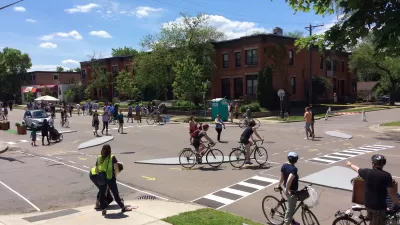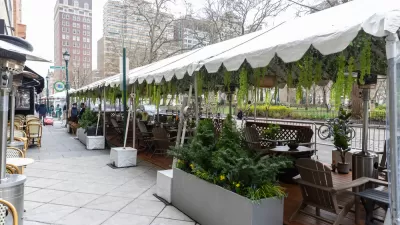Michael Kimmelman looks at the wave of 'cheap, quick, temporary and D.I.Y.-style approaches' that are introducing a more successful means of creating public space than traditional trickle-down techniques.
"Cities need public spaces like plazas," says Kimmelman. "For years they have mostly been planned from the top down. In New York, zoning laws have carved many of these spaces from commercial developments, which have been given bonuses to include them. Mayor Bloomberg is pushing a new proposal to rezone east Midtown, near Grand Central, that is a variation on this same old trickle-down theme."
"But fresh thinking has focused on cheap, quick, temporary and D.I.Y.-style approaches to creating public space — among these, curbside 'parklets' in San Francisco and a communal farm on what had been a derelict parcel in the middle of Phoenix," he explains. "And guess what? A beer garden made out of freight containers on an empty plot turns out to be a lot more popular and better for a city than a sad corporate atrium with a few cafe tables and a long list of don’ts on the wall."
"As more and more educated Americans, especially younger ones, are looking to move downtown, seeking alternatives to suburbs and cars, they’re reframing the demand for public space," Kimmelman continues. "They want elbow room and creative sites, cooked up by the community or, like [New York City's] plaza program, developed from a democratic mix of top-down and bottom-up governance."
FULL STORY: A Streetcorner Serenade for the Public Plaza

Alabama: Trump Terminates Settlements for Black Communities Harmed By Raw Sewage
Trump deemed the landmark civil rights agreement “illegal DEI and environmental justice policy.”

Study: Maui’s Plan to Convert Vacation Rentals to Long-Term Housing Could Cause Nearly $1 Billion Economic Loss
The plan would reduce visitor accommodation by 25% resulting in 1,900 jobs lost.

Planetizen Federal Action Tracker
A weekly monitor of how Trump’s orders and actions are impacting planners and planning in America.

Waymo Gets Permission to Map SF’s Market Street
If allowed to operate on the traffic-restricted street, Waymo’s autonomous taxis would have a leg up over ride-hailing competitors — and counter the city’s efforts to grow bike and pedestrian on the thoroughfare.

Parklet Symposium Highlights the Success of Shared Spaces
Parklets got a boost during the Covid-19 pandemic, when the concept was translated to outdoor dining programs that offered restaurants a lifeline during the shutdown.

Federal Homelessness Agency Places Entire Staff on Leave
The U.S. Interagency Council on Homelessness is the only federal agency dedicated to preventing and ending homelessness.
Urban Design for Planners 1: Software Tools
This six-course series explores essential urban design concepts using open source software and equips planners with the tools they need to participate fully in the urban design process.
Planning for Universal Design
Learn the tools for implementing Universal Design in planning regulations.
Caltrans
Smith Gee Studio
Institute for Housing and Urban Development Studies (IHS)
City of Grandview
Harvard GSD Executive Education
Toledo-Lucas County Plan Commissions
Salt Lake City
NYU Wagner Graduate School of Public Service




























